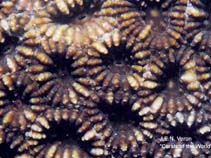Micromussa regularis (Veron, 2000)
Classification / Names Common names | Synonyms | CoL | ITIS | WoRMS
Hexacorallia | Scleractinia | Lobophylliidae
Environment: milieu / climate zone / depth range / distribution range Ecology
Reef-associated; depth range 0 - 30 m (Ref. 848). Tropical; 28°N - 23°S, 95°E - 154°E (Ref. 848)
Distribution Countries | FAO areas | Ecosystems | Occurrences | Introductions
Indo-West Pacific: Indonesia to Papua New Guinea, north to Philippines and south to Queensland, Australia.
Length at first maturity / Size / Weight / Age
Maturity: Lm ? range ? - ? cm
Short description Morphology
Formation: massive and subplocoid. Septa: evenly spaced, some more prominent than others; with 8 to 10 teeth. Teeth: evenly spaced; rounded; often aligned on adjacent septa, forming concentric circles. Weakly developed columellae. Thick tissue over the skeleton absent. Color: variable brown and yellow-brown, usually with contrasting corallite walls and centers (Ref. 848).
Life cycle and mating behavior Maturity | Reproduction | Spawning | Eggs | Fecundity | Larvae
Members of the class Anthozoa are either gonochoric or hermaphroditic. Mature gametes are shed into the coelenteron and spawned through the mouth. Life cycle: The zygote develops into a planktonic planula larva. Metamorphosis begins with early morphogenesis of tentacles, septa and pharynx before larval settlement on the aboral end.
Main reference
References | Coordinator | Collaborators
Veron, J.E.N. 2000. (Ref. 848)
IUCN Red List Status (Ref. 130435: Version 2024-1)
Vulnerable (VU) (A4c); Date assessed: 03 January 2008
CITES status (Ref. 108899)
Appendix II: International trade monitored
CMS (Ref. 116361)
Not Evaluated
Threat to humans
Human uses
| FishSource |
Tools
More information
Trophic Ecology
Food items
Diet
Food consumption
Ration
Predators
Diet
Food consumption
Ration
Predators
Ecology
Population dynamics
Growth
Age/Size
Length-weight
Length-length
Length-frequencies
Mass conversion
Recruitment
Abundance
Age/Size
Length-weight
Length-length
Length-frequencies
Mass conversion
Recruitment
Abundance
Life cycle
Distribution
Human Related
Aquaculture profile
Stamps, Coins Misc.
Stamps, Coins Misc.
Outreach
Taxonomy
References
Internet sources
BHL | BOLD Systems | CISTI | DiscoverLife | FAO(Publication : search) | Fishipedia | GenBank (genome, nucleotide) | GloBI | Gomexsi | Google Books | Google Scholar | Google | PubMed | Tree of Life | Wikipedia (Go, Search) | Zoological Record
Estimates based on models
Preferred temperature
(Ref. 115969): 25.5 - 29.3, mean 28.6 (based on 2101 cells).
Price category
(Ref. 80766):
Unknown.



